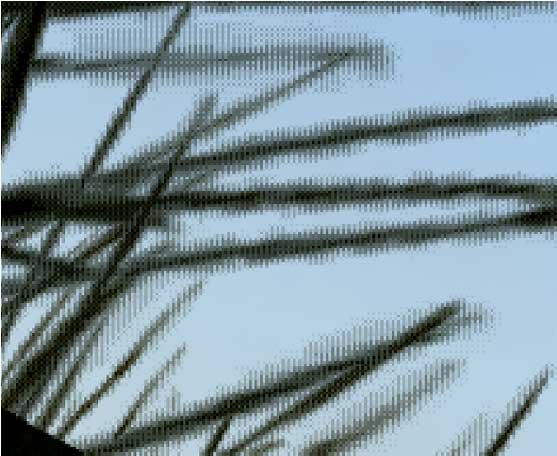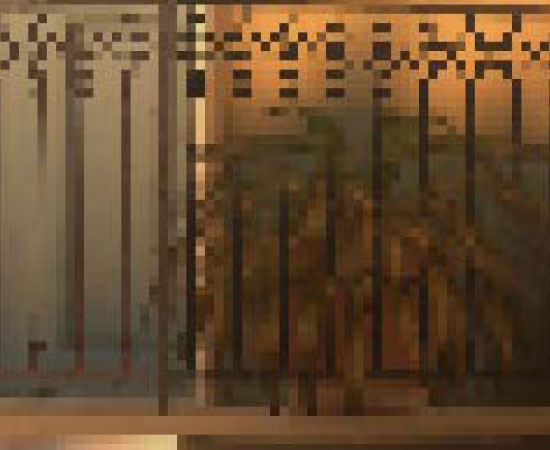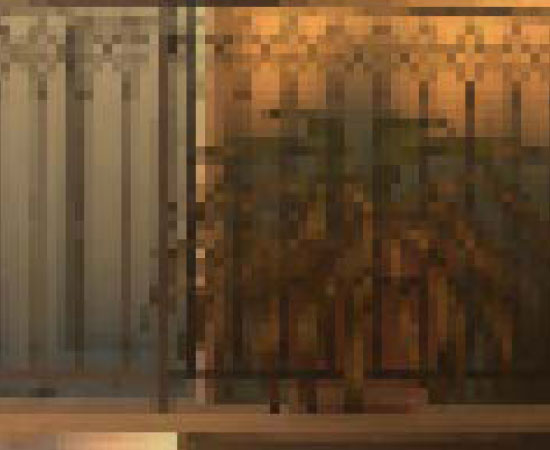Better Image Quality: CSAA & TMAA
NVIDIA’s next big trick for image quality is that they’ve revised Coverage Sample Anti-Aliasing. CSAA, which was originally introduced with the G80, is a lightweight method of better determining how much of a polygon actually covers a pixel. By merely testing polygon coverage and storing the results, the ROP can get more information without the expense of fetching and storing additional color and Z data as done with a regular sample under MSAA. The quality improvement isn’t as pronounced as just using more multisamples, but coverage samples are much, much cheaper.

32x CSAA sampling pattern
For the G80 and GT200, CSAA could only test polygon edges. That’s great for resolving aliasing at polygon edges, but it doesn’t solve other kinds of aliasing. In particular, GF100 will be waging a war on billboards – flat geometry that uses textures with transparency to simulate what would otherwise require complex geometry. Fences, leaves, and patches of grass in fields are three very common uses of billboards, as they are “minor” visual effects that would be very expensive to do with real geometry, and would benefit little from the quality improvement.
Since billboards are faking geometry, regular MSAA techniques do not remove the aliasing within the billboard. To resolve that DX10 introduced alpha to coverage functionality, which allows MSAA to anti-alias the fake geometry by using the alpha mask as a coverage mask for the MSAA process. The end result of this process is that the GPU creates varying levels of transparency around the fake geometry, so that it blends better with its surroundings.
It’s a great technique, but it wasn’t done all that well by the G80 and GT200. In order to determine the level of transparency to use on an alpha to coverage sampled pixel, the anti-aliasing hardware on those GPUs used MSAA samples to test the coverage. With up to 8 samples (8xQ MSAA mode), the hardware could only compute 9 levels of transparency, which isn’t nearly enough to establish a smooth gradient. The result was that while alpha to coverage testing allowed for some anti-aliasing of billboards, the result wasn’t great. The only way to achieve really good results was to use super-sampling on billboards through Transparency Super-Sample Anti-Aliasing, which was ridiculously expensive given that when billboards are used, they usually cover most of the screen.
For GF100, NVIDIA has made two tweaks to CSAA. First, additional CSAA modes have been unlocked – GF100 can do up to 24 coverage samples per pixel as opposed 16. The second change is that the CSAA hardware can now participate in alpha to coverage testing, a natural extension of CSAA’s coverage testing capabilities. With this ability CSAA can test the coverage of the fake geometry in a billboard along with MSAA samples, allowing the anti-aliasing hardware to fetch up to 32 samples per pixel. This gives the hardware the ability to compute 33 levels of transparency, which while not perfect allows for much smoother gradients.
The example NVIDIA has given us for this is a pair of screenshots taken from a field in Age of Conan, a DX10 game. The first screenshot is from a GT200 based video card running the game with NVIDIA’s 16xQ anti-aliasing mode, which is composed of 8 MSAA samples and 8 CSAA samples. Since the GT200 can’t do alpha to coverage testing using the CSAA samples, the resulting grass blades are only blended with 9 levels of transparency based on the 8 MSAA samples, giving them a dithered look.

Age of Conan grass, GT200 16x AA
The second screenshot is from GF100 running in NVIDIA’s new 32x anti-aliasing mode, which is composed of 8 MSAA samples and 24 CSAA samples. Here the CSAA and MSAA samples can be used in alpha to coverage, giving the hardware 32 samples from which to compute 33 levels of transparency. The result is that the blades of grass are still somewhat banded, but overall much smoother than what the GT200 produced. Bear in mind that since 8x MSAA is faster on the GF100 than it was GT200, and CSAA has very little overhead in comparison (NVIDIA estimates 32x has 93% of the performance of 8xQ), the entire process should be faster on GF100 even if it were running at the same speeds as GT200. Image quality improved, and at the same time the performance improved too.

Age of Conan grass, GF100 32x AA
The ability to use CSAA on billboards left us with a question however: isn’t this what Transparency Anti-Aliasing was for? The answer as it turns out is both yes and no.
Transparency Anti-Aliasing was introduced on the G70 (GeForce 7800GTX) and was intended to help remove aliasing on billboards, exactly what NVIDIA is doing today with MSAA. The difference is that while DX10 has alpha to coverage, DX9 does not – and DX9 was all there was when G70 was released. Transparency Multi-Sample Anti-Aliasing (TMAA) as implemented today is effectively a shader replacement routine to make up for what DX9 lacks. With it, DX9 games can have alpha to coverage testing done on their billboards in spite of DX9 not having this feature, allowing for image quality improvements on games still using DX9. Under DX10 TMAA is superseded by alpha to coverage in the API, but TMAA is still alive and well due to the large number of older games using DX9 and the large number of games yet to come that will still use DX9.
Because TMAA is functionally just enabling alpha to coverage on DX9 games, all of the changes we just mentioned to the CSAA hardware filter down to TMAA. This is excellent news, as TMAA has delivered lackluster results in the past – it was better than nothing, but only Transparency Super-Sample Anti-Aliasing (TSAA) really fixed billboard aliasing, and only at a high cost. Ultimately this means that a number of cases in the past where only TSAA was suitable are suddenly opened up to using the much faster TMAA, in essence making good billboard anti-aliasing finally affordable on newer DX9 games on NVIDIA hardware.
As a consequence of this change, TMAA’s tendency to have fake geometry on billboards pop in and out of existence is also solved. Here we have a set of screenshots from Left 4 Dead 2 showcasing this in action. The GF100 with TMAA generates softer edges on the vertical bars in this picture, which is what stops the popping from the GT200.

Left 4 Dead 2: TMAA on GT200

Left 4 Dead 2: TMAA on GF100










115 Comments
View All Comments
marc1000 - Tuesday, January 19, 2010 - link
hey, Banshee was fine! I had one because by that time the 3dfx api was better than DirectX. But suddenly everything became DX compatible and that was one thing 3dfx GPUs could not do... then I replaced that Banshee with a Radeon 9200, later a Radeon X300 (or something), then Radeon 3850, and now Radeon 5770. I'm always in for the mainstream, not the top of the line, and Nvidia is not paying enough atention to mainstream since Geforce FX series...Zool - Monday, January 18, 2010 - link
The question is when they will come with mid range variants. The GF100 seems to be 448SP variant and the 512SP card will be only after A4 revision or who knows.http://www.semiconductor.net/article/438968-Nvidia...">http://www.semiconductor.net/article/43...en_Calls...
The interesting part on the article is the graph which shows the exponecial increase in leakage power after 40nm and less. (which of course hurts more if u have a big chip and diferent clocks to maintain)
They will have even more problems now that dx11 cards will be only gt300 architecture so no rebrand choices for mid range and lower.
For consumer gf100 will be great if they can buy it somewhere in the future, but nvidia will bleed more on it than the GT200.
QChronoD - Monday, January 18, 2010 - link
Maybe I'm missing something, but it seems like PC gaming has lost most of its value in the last few years. I know that you can run games at higher resolutions and probably faster framerates than you can on consoles, but it will end up costing more than all 3 consoles combined to do so. It just seems to have gotten too expensive for the marginal performance advantage.That being said, I bet that one of these would really crank through Collatz or GPUGRID.
GourdFreeMan - Monday, January 18, 2010 - link
I certainly share that sentiment. The last major graphical showcase we had was Crysis in 2007. There have been nice looking PC exclusive titles (Crysis Warhead, Arma 2, the Stalker franchise) since then, but no significant new IP with new rendering engines to take advantage of new technology.If software publishers want our money, they are going to have to do better. Without significant GPGPU applications for the mainstream consumer, GPU manufacturers will eventually suffer as well.
dukeariochofchaos - Monday, January 18, 2010 - link
no, i think you're totally correct, from a certain point of view.i had the thought that the DX9 support is probably more than enough for console games, and why would developers pump money into DX11 support for a product that generates most of it's profits on consoles?
obviously, there is some money to be made in the pc game sphere, but is it really enough to drive game developers to sink money into extra quality just for us?
At least NV has made a product that can be marketed now, and into the future, for design/enterprise solutions. That should help them extract more of the value out of their r&d if there are very few DX11 games for the lifespan of fermi.
Calin - Monday, January 18, 2010 - link
If Fermi is working good, NVidia is in a great place for the development of their next GPU - they'll only need to update some things here and there, based mostly on where the card's performance lack (improve this, improve that, reduce this, reduce that). Also, they are in a very good place for making lower-end cards based on Fermi (cut everything in two or four, no need to redesign the previously fixed function blocks).As for AMD... their current design is in the works and probably too advanced for big changes, so their real Fermi-killer won't come faster than a year or so (that is, if Fermi proves to be so great a success as NVidia wants it to be).
toyota - Monday, January 18, 2010 - link
what I have saved on games this year has more than paid for the difference between the price of a console and my pc.Stas - Tuesday, January 19, 2010 - link
that ^^^^^^^besides, with Steam/D2D/Impulse there is new breath in PC gaming. constant sales on great games, automatic updates, active support, forums full of people, all integrated with virtual community (profiles, chats, etc.). a place to release demos, trailers, etc. I was worried about PC gaming 2-3 years ago, but I'm absolutely confident that it's coming back better than ever.
deeceefar2 - Monday, January 18, 2010 - link
Are the screen shots from left 4 dead 2 missing at the end of page 5?[quote]
As a consequence of this change, TMAA’s tendency to have fake geometry on billboards pop in and out of existence is also solved. Here we have a set of screenshots from Left 4 Dead 2 showcasing this in action. The GF100 with TMAA generates softer edges on the vertical bars in this picture, which is what stops the popping from the GT200.
[/quote]
Ryan Smith - Monday, January 18, 2010 - link
Whoops. Fixed.